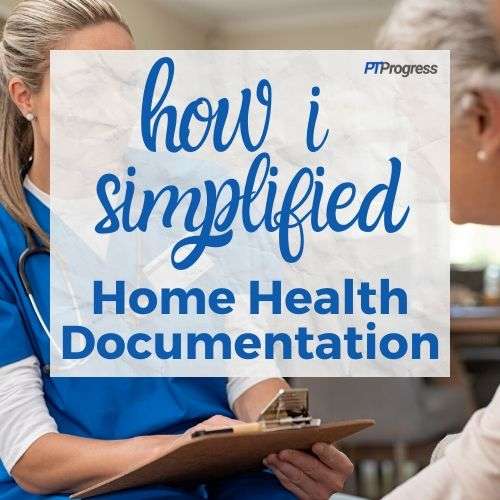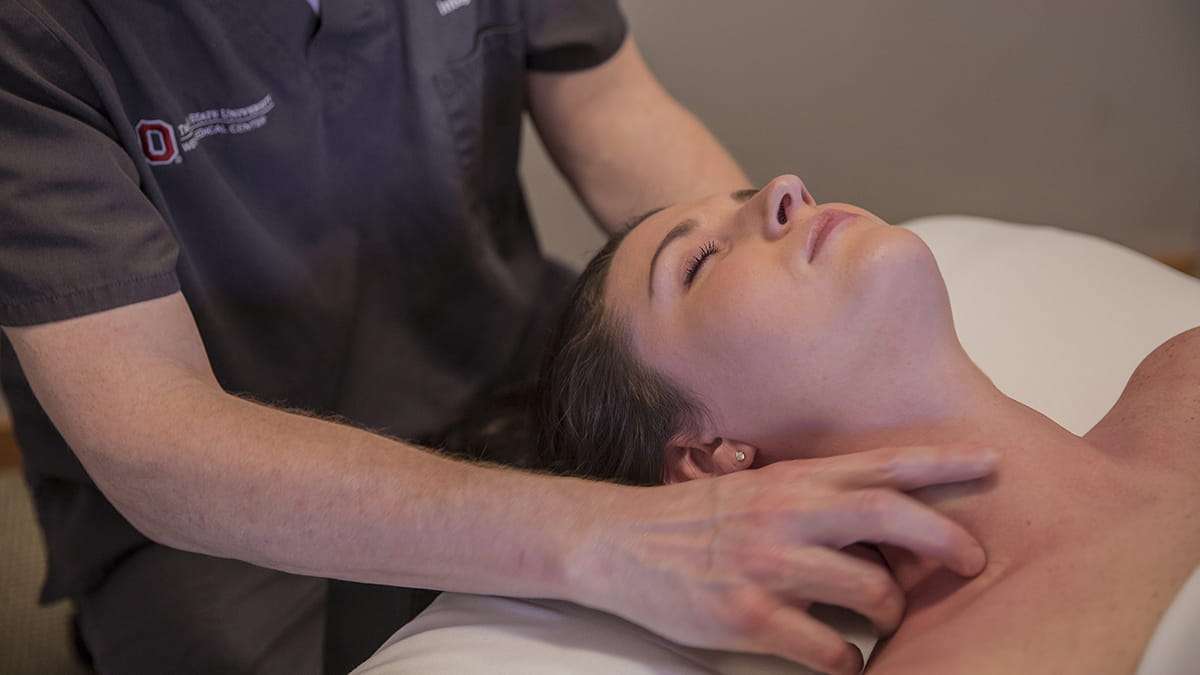
When I started working as a home health Physical Therapist, I looked everywhere for home health documentation examples.
I entered the world of home health from an outpatient clinic, so finding efficient ways to document in the home health setting was difficult at first.
When I figured out the basic outline of a good home health eval, daily note progress note and discharge, I decreased my documentation time by 50%.
It saved me at least an hour each day, which is a big deal when you’re paid per visit.
In this article, I’ll share how I created my own home health templates and share how much time they’ve saved me.
Home Health Documentation Examples
The amount of time it takes to write home health physical therapy documentation (and occupational therapy documentation) will vary depending on the type of note you’re writing. Most therapists eventually come up with some sort of home health template or system to save time when documenting their treatment, but if you’re new to home health, it’s hard to know what to expect!
Creating Home Health Documentation Example Templates
If you’re fortunate to know a therapist at your home health agency who is willing to give you a few of their templated phrases or examples, that’s a huge time saver!
But it can be really kind of awkward asking another therapist if you can have a copy of their personal ‘home health documentation cheat sheet.’
They’ve probably spent hours creating their own unique documentation phrases and they might hesitate giving them to you for various reasons.
When I started as a home health therapist, I made meticulous notes from the therapists who trained me and used their examples to create my own documentation cheat sheets which included:
- Full Home Health Narrative Notes
- Evaluation Summaries
- Physician Verbal Order Templates
- Treatment Note Examples / Flowsheets
- Assessment Phrases & Discharge Summaries
- Entire Therapy Documentation Examples
I spent weeks organizing my notes and creating home health templates that worked for me. For almost an entire year, I kept refining my cheat sheet and created my own little system.
So was it worth it? ABSOLUTELY!
Using my own home health documentation templates, I was able to save 5 to 10 minutes per patient each day.
Just to give you an idea, I might see 5 to 6 patients on a regular day: 2 evals, 3 follow up visits, and a discharge. So saving 10 minutes per patient was an entire hour saved each day!
Since I’m paid per visit, saving time is critical, especially since I’m not paid an hourly rate to do my notes!
I highly encourage you to take a few weeks to create your own home health templates, but if you want a copy of my entire documentation template, you can find the bundle here.
Therapy Documentation Example Time Estimates:
Start of Care – Plan to spend at least 1.5 hours with the patient and 1.5 hours completing the note after the visit. Start of care documentation takes the longest, especially with the newest OASIS changes.
Evaluation – Plan to spend at least 1 hour with the patient and up to 45 minutes after the visit to complete the evaluation note.
Visit Note – For regular follow up visits, plan to spend 30 to 60 minutes with the patient and up to 20 minutes to complete the ‘daily note.’ If you’re efficient, you can often complete the entire note during the home health visit!
Reassessment Note – In Home Health therapy, reassessments are basically like a progress note and take a little longer than a regular visit to complete. Plan to spend 45 to 60 minutes with the patient and up to 20-30 minutes to complete a reassessment note.
Discharge Notes – Plan to spend 30 to 60 minutes with the patient for a discharge visit and an additional 30 minutes after the visit completing the documentation. An OASIS discharge will take longer to complete than a non-OASIS discharge
Download the Home Health Documentation Templates
If you’re a new home health therapist, this guide will save you time and headache as you can actually spend more time focusing on the patient’s needs and treatment.
If you are a veteran home health therapist, this guide can give you fresh ideas on ways to efficiently document your treatments.
Here’s what’s included in the Home Health Documentation Template:
-
Initial Evaluation Summary Example
-
Physician Verbal Order Examples and Script Template
-
Objective Measurement Handout
-
Daily Note Assessment & Documentation of Treatment
-
Progress Note Statements on Goals
-
Discharge Summary Examples
-
Goal Setting Template and Examples
The assessment phrases and narrative note examples are enough to save you at least 5 minutes per patient. With 6 patients a day, that saves you 30 minutes each day.
Therapy Documentation Template Bundle
I mentioned that I spent an entire year crafting my templates and creating a system that saved me time. You can see the entire system in the bundle below, which includes:
- Assessment Templates
- Goal Templates
- Treatment Flowsheets
- Stick Figure Exercises – A huge time saver for home health therapists!
What is your time worth in the evening? Personally, I would have paid over $100 to someone for their documentation templates if it would save me over 3 hours a week in documentation headaches! 🙂
Start your home health career off right with the first and only home health template documentation guide available online. Written by a therapist, for therapists.
The two most important PT/OT documentation requirements are demonstrating that care is (1) medically necessary and (2) skilled.
Care is regarded as “skilled” only if it is at a level of complexity and sophistication that requires the services of a therapist or an assistant supervised by a therapist. Services that do not require the performance or supervision of a therapist are not considered “skilled” even if they are performed by a therapist. Auditors often rely on repetitive or otherwise poor documentation to deny a claim based on the conclusion that therapeutic exercise did not require the skills of a therapist.
A therapist’s skills may be documented by descriptions of skilled treatment, changes made to treatment due to an assessment of the patient’s needs on a particular treatment day or changes due to progress the therapist judged sufficient to modify treatment toward the next more complex or difficult task.
To help therapists and assistants improve their documentation, the following are examples of documentation that clearly demonstrates the skilled nature of therapeutic exercise. (Skilled terminology is highlighted in red.)
1. Patient arrived at therapy with 3/10 L hip pain. Patient instructed in L hip exercises to increase L hip ROM/strength for improved balance and overall pain reduction. In side lying, patient instructed in 3×10 L hip abduction, L hip extension with verbal cues to isolate targeted muscle groups and initiate appropriate exercise. Min A provided due to LE weakness and prevention of substitution movements. Increase of 5 degrees in L hip abduction was achieved through exercises since last reporting period. Patient was able to execute with no reported increase in pain in prep for gait training.
2. In seated position, patient was instructed in LLE strengthening exercises to decrease left foot drop during ambulation prior to functional mobility task. Patient required min verbal cues and visual demo to initiate each exercise using 2# ankle weights for B knee flex/ext. Using red TB, pt. trained in ankle dorsiflexion, plantar flexion, inversion/eversion with 3 second hold. Required max verbal cues, tactile cues and visual demo to reduce compensatory strategies. PT facilitated patient to complete standing ther ex including heel raises with BUE support, using mirror for visual feedback to ensure proper form, 2×15. Increased time needed to execute and allow for therapeutic rest. Patient reporting exercises are helping him “not drag my foot as often.”
3. Patient directed in NuStep training to increase biofeedback to BLE, mimic reciprocal pattern and increase overall BLE strength to decrease abnormal gait pattern. Patient completed x 15 minutes with PT facilitating interval training of varying resistance 1-2 minutes. Patient required verbal cues for erect posture to maximize cardiopulmonary function. O2 monitored pre, during and post exercise with O2 levels > 95% to ensure positive response and reduce risk of desaturation. Patient denied shortness of breath and indicated just right challenge.
4. Patient instructed in BLE recumbent bike training to increase overall functional activity tolerance and LE strength to maximize balance and reduction of falls during mobility. PT directed patient x 18 minutes requiring 2 therapeutic rest breaks due to complaints of fatigue and increased respiration. PT utilized Modified Borg Scale and patient reported 2/10 during exercise. O2 > 96% when monitored during rest breaks, RR 22 post exercise, 18 at baseline. Patient also instructed in pursed lipped breathing to reduce complaints of shortness of breath and elicit usage of energy conservation techniques. Able to mimic after visual demo with good execution.
5. Patient arrived at skilled OT complaining of 5/10 R shoulder pain limiting UE dressing tasks. R shoulder ROM measurements taken as follows: OT assessed and measured R shoulder flexion: 60 degrees, ABD: 58 degrees, EXT: 20 degrees, IR: 20 degrees, ER: 25 degrees. Patient instructed in the following exercises to increase RUE ROM, decrease stiffness and reduce pain level: pulleys 1-2 minutes x 3 trials to increase shoulder flexion with short rest in between trials. Patient reported no increase in pain. OT individualized and instructed patient in AROM exercises to max patient range in pain free zone as follows: IR/ER, abd/add 1×10, extension with 3 second hold. Patient reported “it feels looser.” Patient verbalized 3/10 pain post session indicating positive results from directed exercises.
6. PT educated patient in B hand strengthening exercises post estim to improve overall grip/pincer grasps. Patient trained in the following exercises using moderately resistive putty in order to increase gross grasp and various pinches: gross grasp, opposition, abd/add, tip pinch. Patient required vc and visual demo to perform correctly. Post exercise OT assessed and measured gross grasp: 40# L, 42# R, tip pinch 7# bilaterally (an improvement of 2# each hand for gross grasp and 1# improvement bilaterally for tip pinch from last session). Patient denied pain, just complained of overall “weakness.” Patient reported functional progress with opening jars in prep for feeding and grooming tasks.
7. Patient instructed in the following exercises to increase L wrist/hand ROM, decrease stiffness, reduce pain in order to utilize L hand in task s/p wrist fx. Patient now cleared to begin ROM exercises per MD documentation. Patient is L hand dominant. Patient instructed in L wrist flex/ext, radial/ulnar deviation, opposition, finger abd/add, MCP flex/ext, PIP flex/ext 2×10 with therapeutic rest as needed. Tactile, verbal and visual cues needed to isolate targeted muscle groups. Patient with difficulty noted for radial/ulnar deviation thus OT stabilized patient at the wrist joint to perform accurately and patient was able to complete with overall less pain.
8. Patient instructed in UE bike to maximize UE ROM and strength for improved overall function in tasks. OT graded the task based on patient’s response to exercise. Patient instructed in 5 minutes of level 1 resistance then graded to level 2 resistance for 5 minutes and finally level 3 resistance for the remainder of task. Patient denied SOB or pain, but reported “that was a good workout.” O2 monitored pre, during, and post exercise with readings > 94%. Verbal cues were provided to improve postural alignment and engage in pursed lipped breathing to maximize functional tolerance. Increased time needed for proper positioning prior to exercise to ensure optimal execution of task.
9. Patient presents to skilled PT following CHF exacerbation with reports of feeling breathlessness with community ambulation. Patient educated on use of functional activity tolerance training techniques to increase overall pulmonary function. O2 and RR levels were closely monitored throughout exercise with no abnormal response from baseline when patient was assessed. PT facilitated patient in performing activity tolerance task incorporating UE and LE x 5 minutes x 2 trials with rest in between trials. Patient stated, “wow I’m really out of shape,” but with education on energy conservation techniques, was able to complete the task.
10. Patient presents to skilled PT s/p fall in patient’s bathroom resulting in R sided hip pain and overall weakness. Without PT, patient is at risk for further decline as patient lives alone and was I with all tasks. Due to R sided hip pain, patient having noted difficulty getting out of bed. In supine, patient instructed in R hip abd/add, flex/ext, bridging 3×10 with tactile guiding due to weakness. Increased time needed due to R hip pain as well as to ensure proper form to prevent injury. Will require further skilled services to increase weakened RLE.
11. OT developed HEP and patient instructed in self ROM/stretches to increase I with HEP for BUE exercises. Educated on individualized HEP program, reviewed and facilitated exercises with min vc to initiate. OT facilitated patient to complete scap elevation/depression, scap retraction/protraction with 1×10 with 10 second hold. Patient instructed in green TB exercises for chest fly, shoulder abd, shoulder flexion, elbow flex and extension 2×15. OT modified tasks as needed to allow therapeutic rest needed to maximize strength and functional tolerance. Patient will require further training to ensure I, recall, and overall competence with HEP prior to discharge.
12. Patient arrived at PT with 4/10 R hip pain. Patient educated and instructed in R hip exercises to increase R hip ROM/strength for improved balance, pain reduction, as well as core strengthening to reduce compensatory strategies for improved posture. In side lying, patient instructed in 3×10 R hip abduction using 2.5# weights, prone L hip extension, supine single leg raise to patient’s max tolerance. Able to complete 15 of each exercise prior to modifying task secondary to fatigue. Pt instructed in posterior pelvic tilts 3×10 with 3 sec hold. PT graded task to standing single leg stands for hip flexion and abd on compliant surface 3×10. Patient completed standing Achilles stretch 3x 30sec with mod verbal cues for technique and to engage in pain free range. Min A provided due to RE weakness and prevention of substitution movements. PT assessed progress as follows: Increase of 4 degrees R hip flexion, 3 degrees hip abduction and 2 degrees in extension post ther ex when compared to previous session. Patient was able to execute with no increase in pain in prep for gait training.
13. PT developed functional activity tolerance program and instructed patient in NuStep training to increase biofeedback to BLE, mimic reciprocal pattern and increase overall LE strength to decrease abnormal gait pattern. Overall, patient completed x 15 minutes with PT directing patient with interval training of grading resistance 1-2 minutes. O2 monitored pre, during and post exercise with O2 levels > 95%. PT provided cues to maintain hips in neutral vs. add during task, cues to maintain SPM >55, cues for pursed lipped breathing. RR <20 following task and RPE 2. With PT direction, patient completed task with symmetrical movement 90% of the time.
14. Patient instructed in RLE exercises to increase LE strength s/p R knee replacement. PT instructed patient in the following exercises to improve functional ROM to facilitate improved gait pattern and reduce falls risk with standing tasks. Patient instructed in single leg raise AROM with max vc and tactile cues to focus on quad contraction, quad sets (3 sec muscle contraction with max vc and tactile cues, heel slides with 3 sec hold in flexed position, hip abd with knee ext 2# with cues to maintain hip in neutral and overall correction of technique. Patient progressed this session to standing wall squats with physio ball and min A, heel raises with BUE support and cues for posture. Patient with max cues for posture to reduce trunk sway with standing tasks. Patient with c/o “soreness” but no reports of pain during therex.
15. Patient arrived at OT for engagement in incontinence management including PME’s to reduce urinary urgency. Patient reporting 3 episodes of nocturia increasing risks of falls. OT developed program and patient was instructed in variety of exercises to increase pelvic musculature, reduce urgency and bladder control for overall reduced falls. Patient instructed in glute squeeze, Kegels, hip abd, hip add with pelvic floor activation holding 5 seconds each 3×10. Patient required initial visual demo for ability to isolate targeted muscles and increase carry over. After intervention, was then able to carry out with intermittent cues for pacing and staying on task. By end of session, patient stated, “I have noticed I am able to hold it in longer.”
16. Patient arrived at therapy with RLE weakness and decreased heel strike during assessment of gait. PT facilitated patient to complete standing Achilles stretch and seated quad and HS stretch, 3x 30sec each with mod cues for technique and to complete in pain free range for improved gait pattern and maximize ROM.
17. Patient arrived at therapy 6 weeks post R humeral fracture. New orders from MD for patient to begin ROM per protocol. Patient educated on purpose and instructed in Codman’s exercise x 1-minute x 5 RUE clockwise, then counter clockwise. OT provided stabilization at the shoulder to ensure proper form and to prevent injury. Max vc to execute properly. Patient required standing rest breaks in between each set and 2 seated rest breaks overall. Patient was limited by pain and fatigue, but with encouragement and stabilization, improvement and tolerance noted.
18. Patient arrived at OT with R UE weakness s/p CVA. Post estim to facilitate muscle contraction, patient was instructed in the following exercises to facilitate improved voluntary muscle movement. Patient instructed in GE towel slides flexion/extension and horiz add/abd on table top 3×10 with assistance of LUE as needed; however, OT facilitated constraint therapy to increase RUE movement. Patient frustrated at times, but OT provided hand over hand as needed and patient with resultant improved performance.
19. Patient arrives to therapy with complaints of sciatica. Patient instructed in piriformis, hamstring stretch x 5 BLE, holding 30 seconds each. Patient required mod vc with visual demo to execute properly to avoid injury. Task adapted and modified in response to patient’s complaints, however, patient with increased pain to 8/10 with stretching. PT ceased task to reduce and direct program toward pain management.
20. Patient is at risk for increased back pain without training to stabilize core muscles. PT instructed patient in variety of core strengthening exercises to decrease complaints of back pain. In supine, patient positioned properly to train in posterior pelvic tilts, abdominal crunches 2x 15. Verbal and tactile cues provided to isolate targeted muscle groups and reduce substitution methods. PT graded task to perform in standing side crunches with 5# weight x 10 each side with CGA at times for balance. Patient then instructed in 30 second planks x 3 with rest breaks in between planks to maximize tolerance. Progress to minimal 40 second planks next session but encourage patient to complete to point of fatigue.
_______________________________
Words/phrases that help document skilled care are listed below. However, keep in mind that including one or two of these words/phrases does not in and of itself demonstrate skilled care, the therapist or assistant should use these key words/phrases in notes like the examples above.
• Graded
• Facilitated
• Instructed
• Modified
• Adapted
• Monitored
• Assessed
• Engaged
• Stabilized
• Directed
• Reduced
• Established
• Individualized
• Compensatory Strategies
• Elicited
• Patient is at risk for…
• Inhibit
• Utilized
• Verbal/visual/tactile cues for increased recall, problem solving, sequencing or overall technique
Words and phrases that therapists and assistants should avoid because they often demonstrate lack of skilled care include:
• Tolerated well
• Repetitive language (not individualizing sessions/copy feature)
• Observing
• Supervising
• Continue with POC




